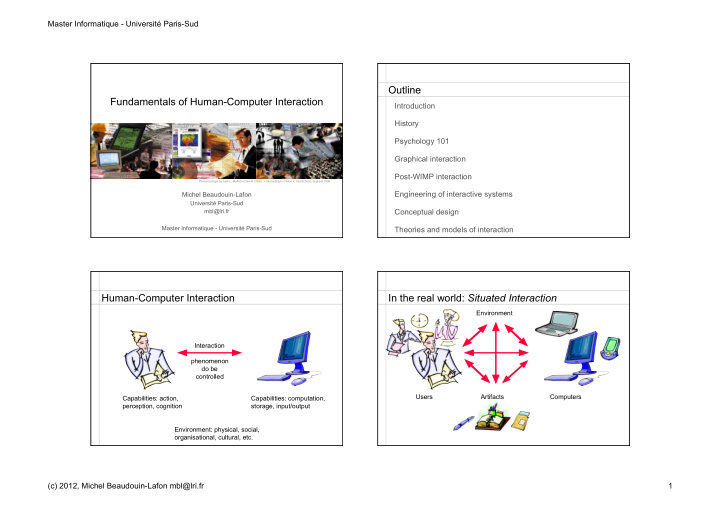



Master Informatique - Université Paris-Sud Outline Fundamentals of Human-Computer Interaction Introduction History Psychology 101 Graphical interaction Post-WIMP interaction Photos/collage by Jack L. Moffet in Dan R. Olsen, « Interacting in Chaos », Interactions, sept-oct 1999. Engineering of interactive systems Michel Beaudouin-Lafon Université Paris-Sud Conceptual design mbl@lri.fr Master Informatique - Université Paris-Sud Theories and models of interaction Human-Computer Interaction In the real world: Situated Interaction Environment Interaction phenomenon do be controlled Users Artifacts Computers Capabilities: action, Capabilities: computation, perception, cognition storage, input/output Environment: physical, social, organisational, cultural, etc. (c) 2012, Michel Beaudouin-Lafon mbl@lri.fr 1
Master Informatique - Université Paris-Sud An interactive system is not ... An interactive system is ... An algorithmic system that: A computer system that: - Reads input - Holds an internal state - Processes it - Creates perceivable representations of part of this state - Writes results - Reacts to input as soon as it arrives See Wegner, Interaction is more powerful than algorithm Two properties of interactive systems Two conceptions of human-computer systems Reactive: « human-in-the-loop » U provides input to S, System-centric view where the user must conform to the system’s rules, e.g. provide input in a specific order or format S must process it immediately and generate output to U Addresses operational tasks where the user performs actions that the computer cannot (yet) do Open: dependencies between S’s output « computer-in-the-loop » and U’s future input are unknown to S Human-centric view where the computer must be adapted to the capabilities of the user Asymmetry: Addresses creative tasks where the computer extends or U does not have to react immediately to S augments the capabilities of the user U likes to know the dependencies between S’s input and output (c) 2012, Michel Beaudouin-Lafon mbl@lri.fr 2
Master Informatique - Université Paris-Sud Conceptual model BEWARE! Model of how this system operates We all use interactive systems We all have ideas of how to improve them ... But few are designers or HCI researchers Responses Paradox of Human-Computer Interaction (HCI): Feedback Operations Objects Measure of success = invisibility, transparency Making things simple is difficult (and difficult to understand) Commands Adaptability of humans is a strength ... and a weakness Ideally, matches the user’s mental model ⇒ HCI is a complex multidisciplinary domain ⇒ Design and HCI research require unique skills Multidisciplinary approach Research strategies: Psychology natural sciences New New anthropology physiology Model model model sociology Theory industrial design psychology visualdesign interactive design systems typography computer engineering architecture electrical Real world engineering mécanichal optics Evaluation Evaluation Observation engineering engineering (c) 2012, Michel Beaudouin-Lafon mbl@lri.fr 3
Master Informatique - Université Paris-Sud Research strategies: Anthropology Research strategies: HCI New New Model model model Theory New New Model model model Theory Interaction Simulation Prototype with an artifact Real world Evaluation Evaluation Observation Real world Observation Evaluation Evaluation The design of interactive systems Interaction paradigms Importance of human factors Computer-as-tool Focus of Few quantitative and/or generative theories First person interfaces the course Augment the user Chaotic aspect of design Small causes, large effects Computer-as-partner Second person interfaces Iterative approach is a necessity Analysis Delegate tasks User-centered design Computer-as-media Evaluation Design Third person interfaces Human-human communication Development (c) 2012, Michel Beaudouin-Lafon mbl@lri.fr 4
Recommend
More recommend